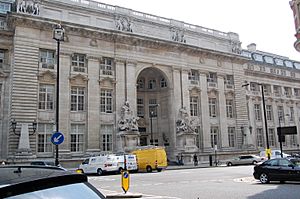Letitia Chitty facts for kids
Quick facts for kids
Letitia Chitty
|
|
|---|---|
| Born | 15 July 1897 |
| Died | 29 September 1982 (aged 85) |
| Nationality | English |
| Alma mater | Newnham College, Cambridge |
| Occupation | Engineer |
| Known for | Aeronautics |
Letitia Chitty (born July 15, 1897 – died September 29, 1982) was a brilliant English engineer. She was known for her work in understanding how structures hold up, especially in planes and airships. Letitia achieved many "firsts" for women in engineering. For example, she was the first female member of the Royal Aeronautical Society and the first woman to receive the important Telford Medal.
Contents
Early Life
Letitia Chitty was born in London, England, on July 15, 1897. She was the oldest of five children, with four sisters and one brother. Her father, Herbert Chitty, was a lawyer and later managed the money for Winchester College, a famous school. Her family included many educated people, like her grandfathers who were a judge and a headmaster.
Education and War Work
Letitia was taught at home and later at Kensington High School until 1916. She then went to Newnham College, Cambridge to study mathematics.
During World War I, when she was just 19, Letitia was chosen for special war work. The British government wanted the best female math students to help. She worked with Alfred Pippard at the Admiralty Air Department. They focused on important calculations for aircraft.
After the war, she went back to her studies. She changed her focus to engineering. In 1921, she graduated from Newnham College with top honors in Mechanical Sciences. She was the first woman ever to do this!
Early Career in Engineering
Letitia's first jobs were all about figuring out the strength of aircraft frames, airships, and other large structures. She started at the Admiralty Air Department. After graduating, she moved to the Air Ministry. There, she worked with famous engineers like Richard Southwell and Alfred Pippard.
The Tarrant Tabor Project
One of her early and very important tasks was checking the strength of a huge bomber plane called the Tarrant Tabor. This plane was designed by W. G. Tarrant. It was meant to be a very large bomber at the end of World War I.
The original design was a biplane (two sets of wings). But it had to be changed to a triplane (three sets of wings) to hold more engines. Letitia was given the job of checking if the new design would be strong enough.
Letitia found that the plane was built with weaker wood than planned. She realized it would not be strong enough. She later said:
"Mr. Tarrant was an inspired timber merchant who dreamed of a super-Camel. It hadn't a chance. It was too big, too heavy - that wasn't its fault, but Grade A spruce had by now run out and it had to be built of American white wood (tulip). In my language, 3,500 instead of 5,500 lb/sq in."
Sadly, her careful math was not fully listened to. The plane crashed nose-first during its very first take-off. This happened at Farnborough Airport on May 26, 1919. Both pilots died, and six other people on board were badly hurt. This tragic event showed how important Letitia's engineering calculations were.
Later Career and Achievements
In 1934, Letitia Chitty moved to Imperial College London. She stayed there for the rest of her career. At first, she continued to study how aircraft structures handle stress. In the 1930s, she helped analyze why the airship R38 crashed. She also wrote many papers about the stress and strain on airship structures. She was an early member of the Women's Engineering Society.
During World War II, Letitia did important research for the British government. She studied how submarine hulls would react to shell attacks. She also worked on strong cables and pulley blocks for barrage balloons. These balloons were used to protect cities from enemy aircraft.
Later in her career, she became interested in the design of arches and arch dams. She worked on projects like the Dukan Dam in Iraq. In 1968, she contributed to an international meeting about arched dams.
Letitia started as a research assistant at Imperial College. She became a lecturer in 1937 and retired in 1962. She achieved many important "firsts" for women engineers:
- She was the first female Fellow of the Royal Aeronautical Society (FRAeS).
- She was the third woman to become a Corporate Member of the Institution of Civil Engineers.
- She was the first woman appointed to an ICE technical committee in 1958.
She won four Telford Premium medals for papers she wrote with Alfred Pippard. In 1969, she became the first woman to receive the Telford Gold Medal, which is a very high honor in engineering.
Letitia loved to travel. In 1948, she published a book called "Abroad. An alphabet of Flowers." It included her own drawings and notes from her holidays.
After she passed away, Letitia left money to Imperial College. The college named its Library reading room after her. Imperial College also gives out a "Letitia Chitty Centenary Memorial Prize." Newnham College also has a "Letitia Chitty Award for Engineering."
See also
 In Spanish: Letitia Chitty para niños
In Spanish: Letitia Chitty para niños


